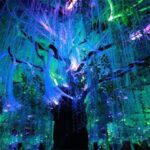Shanghai Wenmiao Temple, originally established during the Yuan Dynasty (1294 AD), has been relocated several times before settling at its current location. The temple complex visible today was constructed in the fifth year of the Xianfeng Emperor’s reign of the Qing Dynasty (1855 AD). It features grand Ming and Qing style architecture, serene Jiangnan garden landscapes, and exhibitions of peculiar stones, root carvings, and teapots, as well as displays of ancient literary inscriptions from Shanghai. The temple layout consists of a three-part courtyard; the first part is divided into upper and lower courtyards, the second part is the Lingxing Gate, with Kuiwen Pavilion and Zunjing Pavilion at both ends, and the third part is a quadrangle formed by the Dacheng Gate, Dacheng Hall, and two drum towers. In front of the Dacheng Hall, there are eastern and western wing halls, which together with the Dacheng Gate and the enclosing wall form a closed courtyard, housing exhibitions of calligraphy couplets from the Ming and Qing dynasties. In front of the Dacheng Hall, there is a statue of Confucius and the Dacheng Bell, where many students visit to make wishes and ring the bell before exams, tying red ribbons on the trees in front of the hall for good luck. Dacheng Hall is the main hall for worshipping Confucius, and it displays over 16,400 characters of the Analects written by Shanghai calligrapher Liu Xiaoqing in regular script, carved on 52 bluestone slabs and embedded around the inner walls of the hall, with exquisite craftsmanship. Moving eastward is the Zunjing Pavilion, which was first built during the Chenghua period of the Ming Dynasty and was one of the earliest official libraries in Shanghai. In front of the pavilion is a Lingbi stone resembling a qilin. The Mingle Hall, located south of the Zunjing Pavilion, was a place for Confucian scholars to lecture, with neatly arranged study cases visible inside. In front of the hall stands a square bronze ding with inscriptions ‘Learn extensively from the culture, and be restrained by the rites’ and ‘Never tire of learning, never weary of teaching.’ The Kuixing Pavilion, a three-story structure located at the eastern end of the temple and built in 1855, is the main building of the academy. It is a rare ancient pavilion in the urban area of Shanghai, with its flying eaves and pointed roof exuding a strong sense of history. It is said that in the past, one could overlook the entire old city of Shanghai from this pavilion. In front of the pavilion is a pond surrounded by lush vegetation, resembling a miniature garden, with a ‘Dragon Roar, Tiger Growl’ Lingbi stone standing in the pond, very vivid. Around the temple, along Laodaoqian Street, Menghua Street, and Xuegong Street, there are antique shops, calligraphy and painting studios, ancient coin, and stamp stores with a strong cultural flavor. Occasionally, elderly people set up stalls to sell antiques. The area also boasts numerous street snacks, doll shops, stationery stores, and small merchandise shops, making it a favored destination for students and young people. Notably, there is a book market in the northeast corner of the temple, offering discounted books. Every Sunday, there is a second-hand book market inside the temple (not held in rainy weather), where one can enter for a mere one yuan and find a vast array of ancient books, used books, new books, comics, and foreign books. With patience, one is sure to find something of interest after a few hours of browsing, making it a must-visit for book lovers. The temple is open all year round from 09:00 to 16:30, with Zhou Huikun Calligraphy Art Museum closed on Mondays.
The specific business status is subject to the opening conditions on the day.









